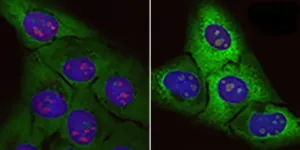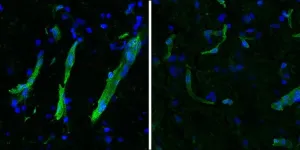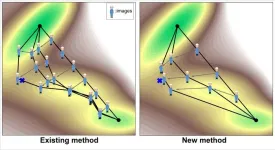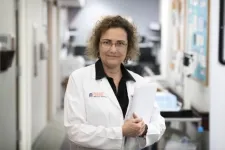(Press-News.org) It’s no surprise that your dog can learn to sit when you say “sit” and come when called. But a study appearing March 22 in the journal Current Biology has made the unexpected discovery that dogs generally also know that certain words “stand for” certain objects. When dogs hear those words, brain activity recordings suggest they activate a matching mental representation in their minds.
“Dogs do not only react with a learned behavior to certain words,” says Marianna Boros (@FamDogProject) of the Department of Ethology at the Eötvös Loránd University, Budapest, Hungary, one of the paper’s co-first authors. “They also don’t just associate that word with an object based on temporal contiguity without really understanding the meaning of those words, but they activate a memory of an object when they hear its name.”
Word understanding tests with individuals who do not speak, such as infants and animals, usually require active choice, the researchers say. They’re asked to show or get an object after hearing its name. Very few dogs do well on such tests in the lab, often fetching objects correctly at a rate expected by chance.
The researchers wanted to look closer at dogs’ implicit understanding of object words by measuring brain activity using non-invasive EEG without asking them to act. The idea was that this might offer a more sensitive measure of their understanding of language.
In their studies, they had 18 dog owners say words for toys their dogs knew and then present the objects to them. Sometimes they presented the matching toy, while other times they would present an object that didn’t match. For example, an owner would say, “Zara, look, the ball,” and present the object while the dog’s brain activity was captured on EEG.
The brain recording results showed a different pattern in the brain when the dogs were shown a matching object versus a mismatched one. That’s similar to what researchers have seen in humans and is widely accepted as evidence that they understand the words. The researchers also found a greater difference in those patterns for words that dogs knew better, offering further support for their understanding of object words. Interestingly, while the researchers thought this ability might depend on having a large vocabulary of object words, their findings showed that it doesn’t.
“Because typical dogs learn instruction words rather than object names, and there are only a handful of dogs with a large vocabulary of object words, we expected that dogs’ capacity for referential understanding of object words will be linked to the number of object words they know; but it wasn’t,” says Lilla Magyari, also of Eötvös Loránd University and University of Stavanger and the other co-first author.
“It doesn’t matter how many object words a dog understands—known words activate mental representations anyway, suggesting that this ability is generally present in dogs and not just in some exceptional individuals who know the names of many objects,” Boros added.
The discovery that dogs as a species may generally have a capacity to understand words in a referential way, just as humans do, might reshape the way scientists think about the uniqueness of how humans use and understand language, the researchers say. That has important implications for theories and models of language evolution. For dog owners, it’s also an important realization.
“Your dog understands more than he or she shows signs of,” Magyari says. “Dogs are not merely learning a specific behavior to certain words, but they might actually understand the meaning of some individual words as humans do.”
The researchers are now curious to know if this ability to understand referential language is specific to dogs or might be present in other mammals as well. Either way, they want to learn more about how this ability emerged and whether it depends on dogs’ unique experience of living with people. They also want to know why, if dogs understand object words, more of them don’t show it.
###
Funding information can be found in the paper under acknowledgements. The authors declare no competing interests.
Current Biology, Boros and Magyari et al.: “Neural evidence for referential understanding of object words in dogs,” https://www.cell.com/current-biology/fulltext/S0960-9822(24)00171-4
Current Biology (@CurrentBiology), published by Cell Press, is a bimonthly journal that features papers across all areas of biology. Current Biology strives to foster communication across fields of biology, both by publishing important findings of general interest and through highly accessible front matter for non-specialists. Visit http://www.cell.com/current-biology. To receive Cell Press media alerts, contact press@cell.com.
END
It’s no surprise that dogs can learn to understand and respond to human words. Your dog can learn to sit when you say “sit” and come when called. But a new study has made the surprising discovery by recording brain activity that dogs generally also know that certain words “stand for” certain objects. When they hear those words, they activate a matching mental representation in their minds.
“Dogs do not only react with a learned behavior to certain words,” says Marianna Boros of the Department of Ethology at the Eötvös Loránd University, Budapest, Hungary. “They also don’t just associate that word with an object ...
CNIO researchers provide a new hypothesis to understand the origin of amyotrophic lateral sclerosis, or ALS. It would be triggered by a similar problem to that occurring in a group of rare diseases called ribosomopathies.
In ALS patients, motor neurons would accumulate an excess of non-functional ribosomal proteins that eventually collapse the cell's clearance systems and cause toxicity.
The study also opens a new front in aging research. The authors provide experimental evidence that formally proves a kind of stress called ‘nucleolar stress’ cause aging in mammals.
Amyotrophic lateral sclerosis (ALS) is a degenerative disease. ...
On the surface, the movement disorder amyotrophic lateral sclerosis (ALS), also known as Lou Gehrig’s disease, and the cognitive disorder frontotemporal lobar degeneration (FTLD), which underlies frontotemporal dementia, manifest in very different ways. In addition, they are known to primarily affect very different regions of the brain.
However, doctors and scientists have noted several similarities over the years, and a new study in Cell reveals that the diseases have remarkable overlaps at the cellular and molecular levels, revealing potential targets that could yield therapies applicable ...
About The Study: In this study of 5,437 U.S. adults with health care visits in 2022, many patients, including those with the greatest care needs, chose telemedicine even after in-person visits were available. These findings support continuing this care delivery approach as an option valued by patients. Differences were not observed by most common measures of socioeconomic status. Continued monitoring of telemedicine use is needed to ensure equitable access to health care innovations.
Authors: Eva ...
About The Study: The results of this study of Medicare enrollees suggest that although nationally, Black and Hispanic individuals and individuals of other racial groups received more telemedicine visits during the pandemic and disproportionately lived in geographic regions with higher telemedicine use, after controlling for geographic region, Black and Hispanic individuals and individuals of other racial groups received fewer telemedicine visits than white individuals.
Authors: Felippe O. Marcondes, M.D., M.P.H., of Massachusetts General ...
More than half of all new doctors face some form of sexual harassment in their first year on the job, including nearly three-quarters of all new female doctors and a third of males, a new study finds.
That’s actually down somewhat from the percentage of new doctors who experienced the same five or six years before, according to the paper published in JAMA Health Forum by a team from the University of Michigan Medical School and Medical University of South Carolina.
And today’s ...
Academics are proposing a new and improved way to help researchers discover when consciousness emerges in human infancy.
When over the course of development do humans become conscious? When the seventeenth-century French philosopher René Descartes was asked about infant consciousness by his critics, he eventually suggested that infants might have thoughts, albeit ones that are simpler than those of adults. Hundreds of years later, the issue of when human beings become conscious is a question which remains a challenge for psychologists and philosophers alike.
But now, in response to a recent ...
A computational method for finding transition states in chemical reactions, greatly reducing computational costs with high reliability, has been devised. Compared to the most widely used existing method, the present method reduces the total computational cost by approximately 50 to 70%. The development, available on GitHub, is poised to accelerate advancements in material science, making the exploration of chemical reactions more accessible and efficient. This could lead to faster scientific discoveries and technological innovations.
In chemical reactions, substances ...
There were multiple unsafe sleep practices at play in more than three-quarters of Sudden Unexpected Infant Deaths reported in 23 jurisdictions between 2011 and 2020, a new study reveals. The researchers say the findings underscore the need for more comprehensive safe-sleep education for new parents, including from healthcare providers.
Of 7,595 infant deaths reviewed, almost 60% of the infants were sharing a sleep surface, such as a bed, when they died. This practice is strongly discouraged by sleep experts, who warn that a parent or other bed partner could unintentionally ...
HOUSTON ― The Institute for Data Science in Oncology (IDSO) at The University of Texas MD Anderson Cancer Center today announced the appointment of its inaugural cohort of IDSO Affiliates. These 33 talented scientists, clinicians and staff bring diverse expertise to help IDSO leadership and focus area co-leads advance collaborative data science projects and align the institute’s efforts with MD Anderson’s mission to end cancer.
“We are proud to welcome these exceptional individuals to the growing IDSO community, and we look forward ...






